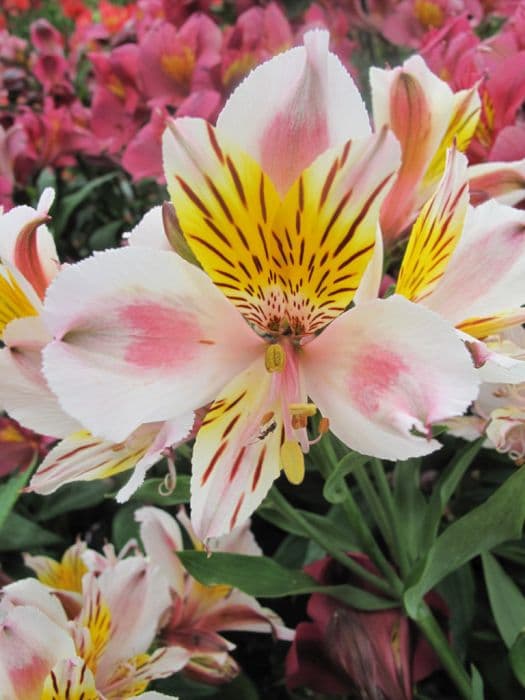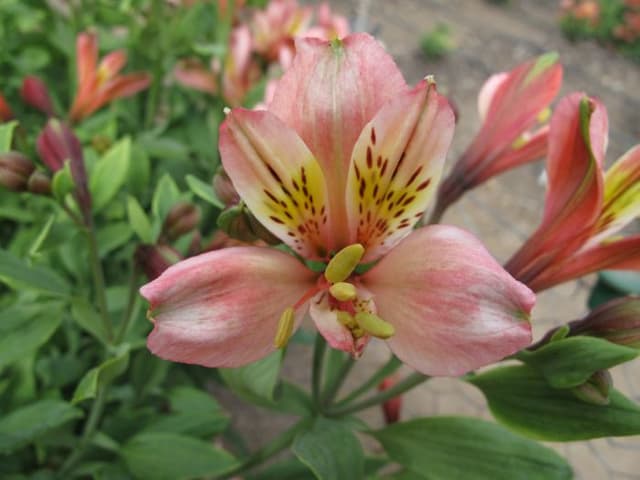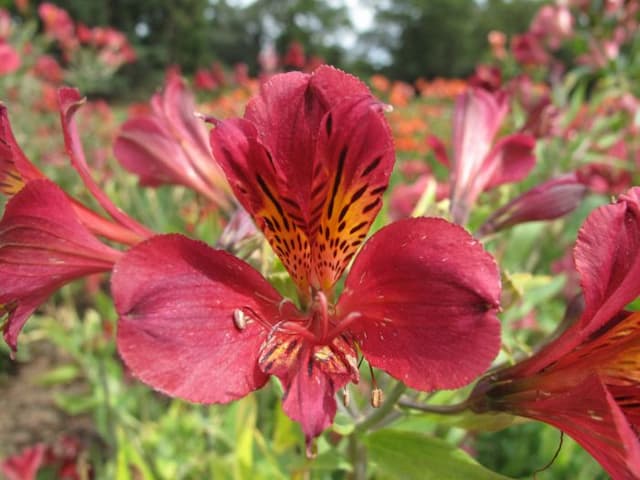Peruvian Lily Alstroemeria Inca Smile = 'Koncasmile' (PBR) (Inca Series)
![Peruvian lily [Inca Smile]](/_next/image?url=https%3A%2F%2Fplants-admin.emdemapps.com%2Fimages%2Fplants%2F%2Fimages%2F604b5cad8fa91.png&w=3840&q=75)
ABOUT
The Alstroemeria Inca Smile, part of the Inca Series, is renowned for its vibrant and striking appearance. This plant features a lush display of lance-shaped, green leaves that provide a rich backdrop for the star of the show – its flowers. The blooms are particularly eye-catching, boasting a gorgeous mix of yellow and orange hues embellished with unique, dark speckling and streaks within the flower's throat. Each flower showcases six petals and is often likened to miniature lilies because of their form and elegance. These blossoms cluster together at the top of slender, upright stems, creating an impressive burst of color that adds an element of cheerfulness to any garden. Overall, the Alstroemeria Inca Smile's visual appeal makes it a popular choice for both garden enthusiasts and for cutting gardens, as the flowers are long-lasting when snipped and arranged in vases. The overall look of the plant is one of lush foliage and vibrant, warm-toned blooms that can brighten any setting.
About this plant
 Names
NamesFamily
Alstroemeriaceae
Synonyms
Peruvian Lily, Lily of the Incas, Inca Lily
Common names
Alstroemeria Inca Smile = 'Koncasmile' (PBR) (Inca Series)
 Toxicity
ToxicityTo humans
The plant commonly known as Peruvian lily is not considered highly toxic to humans. However, it should not be ingested as it may cause mild gastrointestinal irritation, such as nausea, vomiting, or diarrhea, if consumed. The sap may also cause skin irritation for some individuals.
To pets
The Peruvian lily is mildly toxic to cats and dogs. If a pet ingests this plant, it may experience mild signs of gastrointestinal upset, such as vomiting or diarrhea. It is advisable to keep an eye on your pet and contact a veterinarian if they consume any part of the plant and show signs of distress.
 Characteristics
CharacteristicsLife cycle
Perennials
Foliage type
Evergreen
Color of leaves
Green
Flower color
Mixed
Height
2-3 feet (60-90 cm)
Spread
1-2 feet (30-60 cm)
Plant type
Herb
Hardiness zones
7
Native area
South America
Benefits
 General Benefits
General Benefits- Long Blooming Period: Alstroemeria Inca Smile typically blooms for several months, providing a consistent display of color.
- Vibrant Flowers: It produces bright, colorful flowers that can add a splash of color to any garden or bouquet.
- Attracts Pollinators: The flowers attract beneficial insects like bees and butterflies, promoting pollination in the garden.
- Drought Tolerance: Once established, the plant is quite tolerant of dry conditions, requiring less frequent watering.
- Low Maintenance: Alstroemeria Inca Smile is known for being relatively easy to care for, needing only basic maintenance.
- Cut Flower Potential: The blooms are long-lasting when cut, making them a great choice for floral arrangements.
- Compact Growth: As part of the Inca Series, this variety tends to have a more compact growth habit, suitable for smaller gardens or containers.
- Cold Hardy: It is capable of withstanding cooler temperatures, allowing it to be grown in a variety of climates.
 Medical Properties
Medical PropertiesThis plant is not used for medical purposes.
 Air-purifying Qualities
Air-purifying QualitiesThis plant is not specifically known for air purifying qualities.
 Other Uses
Other Uses- Photography Prop: Alstroemeria, with its vibrant colors, can serve as an excellent subject or background for botanical photography, enhancing the visual appeal of the photographs.
- Craft Projects: The petals and leaves can be used in scrapbooking or pressed flower art, preserving their beauty in a creative and lasting form.
- Fabric Dye: Alstroemeria flowers can be used to create a natural dye for fabrics, providing a range of subtle colors based on the pigments present in the blooms.
- Greeting Cards: Fresh or dried Alstroemeria flowers can be attached to handmade greeting cards for a 3D effect and a personal touch.
- Educational Tools: The plant can be employed in botany classes to teach students about plant reproduction, pollination, and hybridization strategies.
- Table Centerpiece: When combined with other foliage and flowers, Alstroemeria can create an attractive and long-lasting table centerpiece for events.
- Bio-Art: Can be included in bio-art installations where plants are integrated into live art pieces for expression or commentary on nature and biology.
- Floral Ice Cubes: Freeze small Alstroemeria blooms into ice cubes to add a decorative touch to summer drinks and cocktails.
- Culinary Garnish: Alstroemeria flowers can be used as a non-toxic garnish for desserts and pastries, as long as they have not been treated with any chemicals.
- Scented Potpourri: Dried Alstroemeria flowers can contribute to a potpourri mix, adding a mild pleasant aroma and a splash of color to a room.
Interesting Facts
 Feng Shui
Feng ShuiThe Peruvian Lily is not used in Feng Shui practice.
 Zodiac Sign Compitability
Zodiac Sign CompitabilityThe Peruvian Lily is not used in astrology practice.
 Plant Symbolism
Plant Symbolism- Friendship: Alstroemeria, also known as Peruvian Lily, is often associated with deep bonds and lasting friendships because of its twisted leaves, which represent the trials and tribulations that friendships endure.
- Devotion: The Peruvian Lily symbolizes a mutual connection and dedication between two people, often used to express one's commitment and personal bonds.
- Wealth and Prosperity: With its multiple blooms and long-lasting nature, the Peruvian Lily signifies abundance and affluence, making it a great gift to wish someone financial stability and success.
- Achievement: The vibrant and diverse colors of the Peruvian Lily represent diversity in success and the achievement of multiple goals or challenges.
- Fortitude: Peruvian Lilies are durable and resilient, thus symbolizing strength and the ability to withstand challenges in life.
 Water
WaterInca Lilies should be watered once the top inch of soil feels dry to the touch, which often translates to approximately once a week, though it may vary depending on environmental conditions. It's important to water the plant thoroughly until excess water drains out of the bottom, ensuring deep hydration. During the growing season, in warmer months, you might need to water them more frequently, possibly increasing to twice a week depending on temperature and humidity levels. During the winter, watering should be reduced to every other week or less, as the plant requires less moisture when not actively growing. It's important to provide about 1 to 1.5 gallons of water at each watering session to ensure adequate hydration for a medium-sized plant.
 Light
LightInca Lilies prefer bright, indirect light and should be positioned in a spot where they receive this type of light for optimal growth and flowering. They can tolerate some direct morning sun, but harsh afternoon sunlight can damage the foliage and flowers. A north- or east-facing window is typically an ideal location for these plants inside, whereas a partially shaded area works well when they are grown outdoors.
 Temperature
TemperatureInca Lilies thrive in temperatures that range from 65 to 80 degrees Fahrenheit; however, they can withstand minimum temperatures down to around 50 degrees Fahrenheit for brief periods. It is critical to protect them from frost, as temperatures below 50 degrees Fahrenheit can severely damage or even kill the plant. They perform best when the temperature during the day is on the warmer side within their tolerance range and slightly cooler at night.
 Pruning
PruningPruning Inca Lilies is essential to remove spent flowers and to encourage further blooming. This can be done by snipping off dead flower stems at the base. Additionally, removing any damaged or yellowing leaves helps to maintain the plant's health and appearance. It's best to prune regularly throughout the blooming season to promote continuous flower production. Pruning should be done with clean, sharp tools to avoid damaging the plant.
 Cleaning
CleaningAs needed
 Soil
SoilThe Peruvian Lily (Alstroemeria) thrives best in fertile, well-draining soil with a pH range of 6.0 to 7.0. A mix of loam, peat, and sharp sand or perlite can provide good structure and drainage. Regular feeding with a balanced fertilizer during the growing season is also beneficial.
 Repotting
RepottingPeruvian Lilies typically require repotting every two to three years as they grow to ensure they have enough space for their tuberous roots. Repotting is best done in the spring before active growth begins.
 Humidity & Misting
Humidity & MistingPeruvian Lilies enjoy moderate to high humidity levels. Aim to maintain indoor humidity around 40-60% for optimal growth and flower production, avoiding excessively dry air which can impede their well-being.
 Suitable locations
Suitable locationsIndoor
Place in bright indirect light, ensure proper drainage.
Outdoor
Plant in part sun, sheltered from strong winds.
Hardiness zone
7-10 USDA
 Life cycle
Life cycleAlstroemeria, commonly known as Peruvian lily or lily of the Incas, begins its life cycle when seeds or rhizomes are planted in well-drained soil during early spring or from divisions made in the autumn. The rhizomes germinate or the divisions establish themselves, developing into vegetative growth that includes long, slender leaves and stems. As temperatures warm, it enters a rapid growth phase, preparing for flowering, which occurs in late spring through summer, showcasing stunning, colorful blossoms. After the flowering season, if pollination occurs, the plant may produce seed capsules, although many cultivars are propagated primarily through division rather than seeds. In the autumn, the above-ground growth of the Peruvian lily begins to die back as it enters a period of dormancy, especially in cooler climates, with the underground rhizomes surviving through winter. Come the following spring, the plant will re-emerge from the rhizomes, continuing its growth cycle and producing new shoots that will mature into the next flowering season.
 Propogation
PropogationPropogation time
Spring-Early Summer
Propogation: Alstroemeria Inca Smile, commonly referred to as Peruvian Lily, is often propagated through division, which is most effectively carried out in late summer to early fall when the plant is not actively blooming. This method involves gently digging up an established clump of the plant, taking care not to damage the tuberous roots, and separating the clump into smaller sections. Each section should have several shoots or eyes from which new growth can emerge. Replant the divisions promptly, spacing them about 12 to 18 inches apart (30 to 45 centimeters) and at the same depth they were growing previously. Water the newly planted divisions well to help establish them. This method ensures that the unique characteristics of the 'Koncasmile' cultivar are maintained, as seed propagation may result in variations from the parent plant.



![Peruvian lily [Inca Glow]](/_next/image?url=https%3A%2F%2Fplants-admin.emdemapps.com%2Fimages%2Fplants%2F%2Fimages%2F604b5e99e48d9.png&w=640&q=75)
![Peruvian lily [Inticancha Passion]](/_next/image?url=https%3A%2F%2Fplants-admin.emdemapps.com%2Fimages%2Fplants%2F%2Fimages%2F604b5f7a78c8d.png&w=640&q=75)


![Peruvian lily [Summer Breeze]](/_next/image?url=https%3A%2F%2Fplants-admin.emdemapps.com%2Fimages%2Fplants%2F%2Fimages%2F604b6401573b7.png&w=640&q=75)

